Abstract
The increasing emergence of penicillin-resistant and multiresistant strains of Streptococcus pneumoniae may pose a problem in coming years. We therefore compared sparfloxacin, a new fluoroquinolone with improved potency against streptococci, with amoxicillin, the "gold standard" in this setting, and another fluoroquinolone, ciprofloxacin, in a mouse pneumonia model. Their efficacies against penicillin-susceptible (serotype 3), macrolide-resistant (serotype 1), penicillin-resistant (serotype 23), and multiresistant (serotype 6) S. pneumoniae strains were evaluated. Immunocompetent Swiss mice (serotypes 1 and 3) and leukopenic mice (serotypes 6 and 23) were infected by peroral tracheal delivery of 10(4) to 10(6) CFU. Subcutaneous injections of antibiotics were initiated at 6, 18, 48, or 72 h after infection (six injections at 12-h intervals). In the immunocompetent mice, 100% survival was obtained with sparfloxacin (50 mg/kg) and amoxicillin (5 mg/kg) against both penicillin-susceptible and macrolide-resistant strains; ciprofloxacin gave significantly lower survival rates. Two to four injections of sparfloxacin completely cleared bacteria from lungs and blood; the most rapid eradication was achieved with amoxicillin. Sparfloxacin also fully protected leukopenic mice against penicillin-resistant strains. The dose of amoxicillin (50 mg/kg) required to protect mice and eradicate penicillin-resistant and multiresistant strains was 10 times higher than that effective against penicillin-susceptible strains. The microbiological and pharmacokinetic properties of sparfloxacin (e.g., the time during which concentrations exceed the MIC of the test pathogen) accounted for its efficacy against susceptible and resistant strains of S. pneumoniae in this model.
Full text
PDF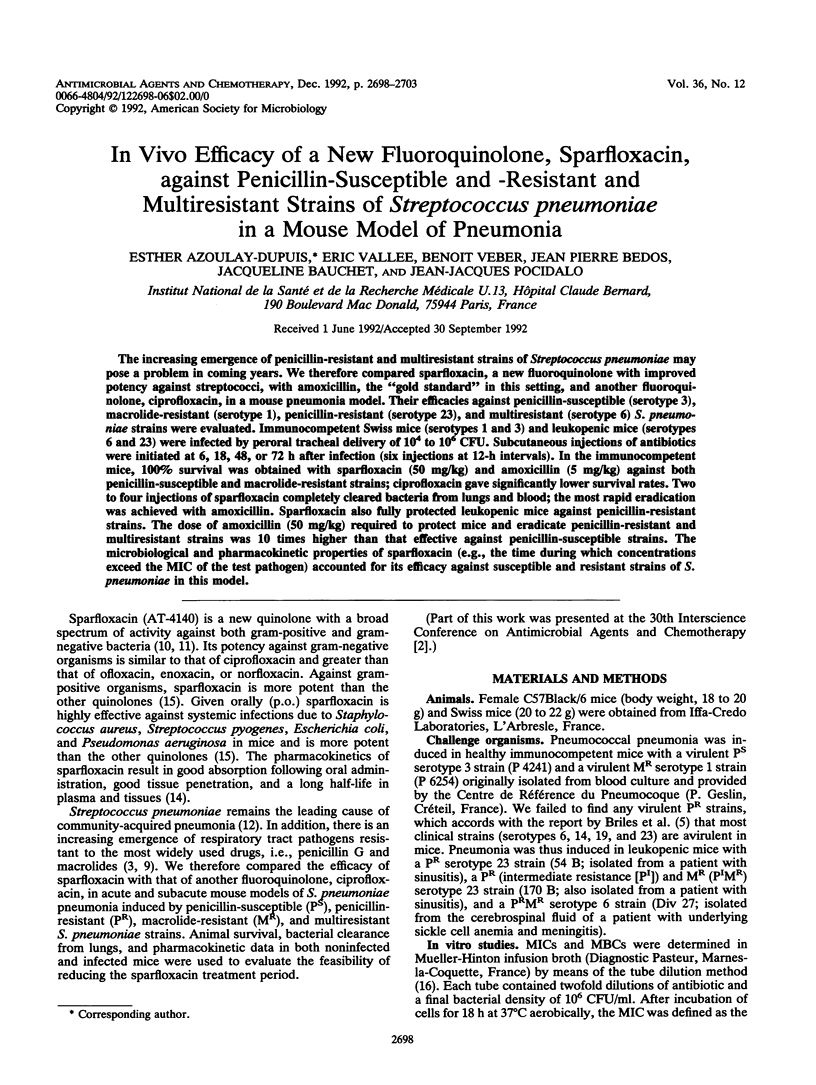
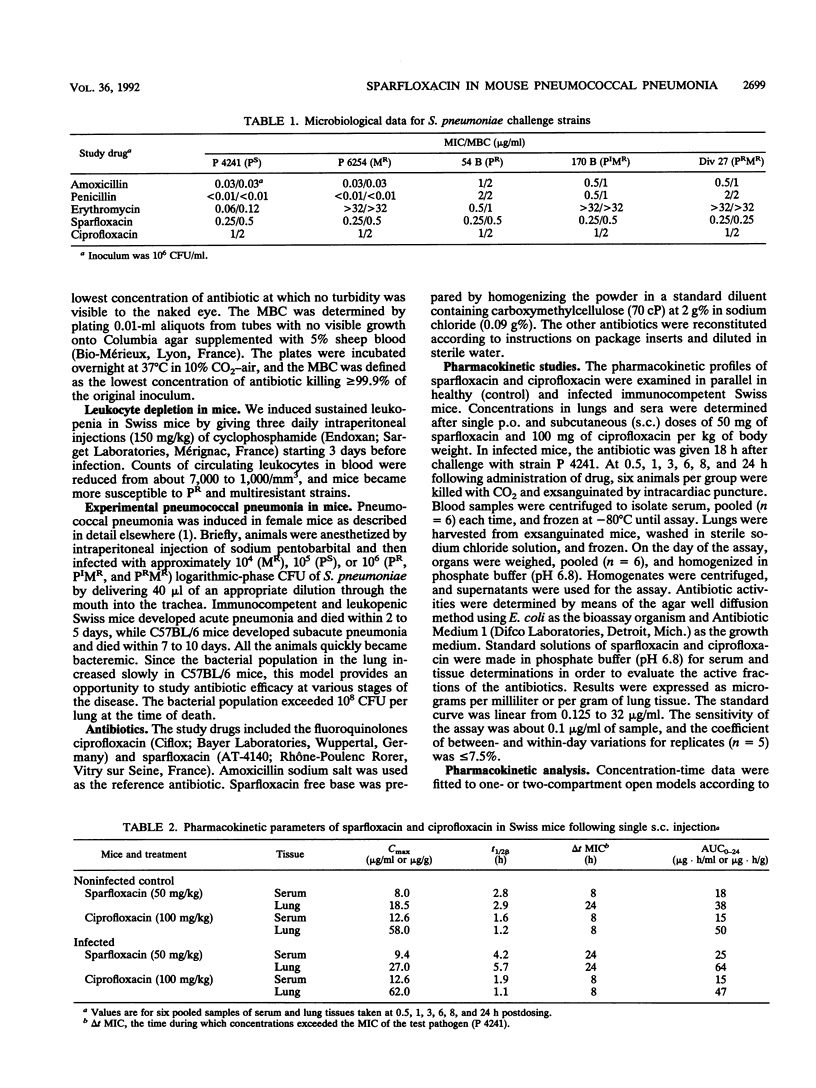
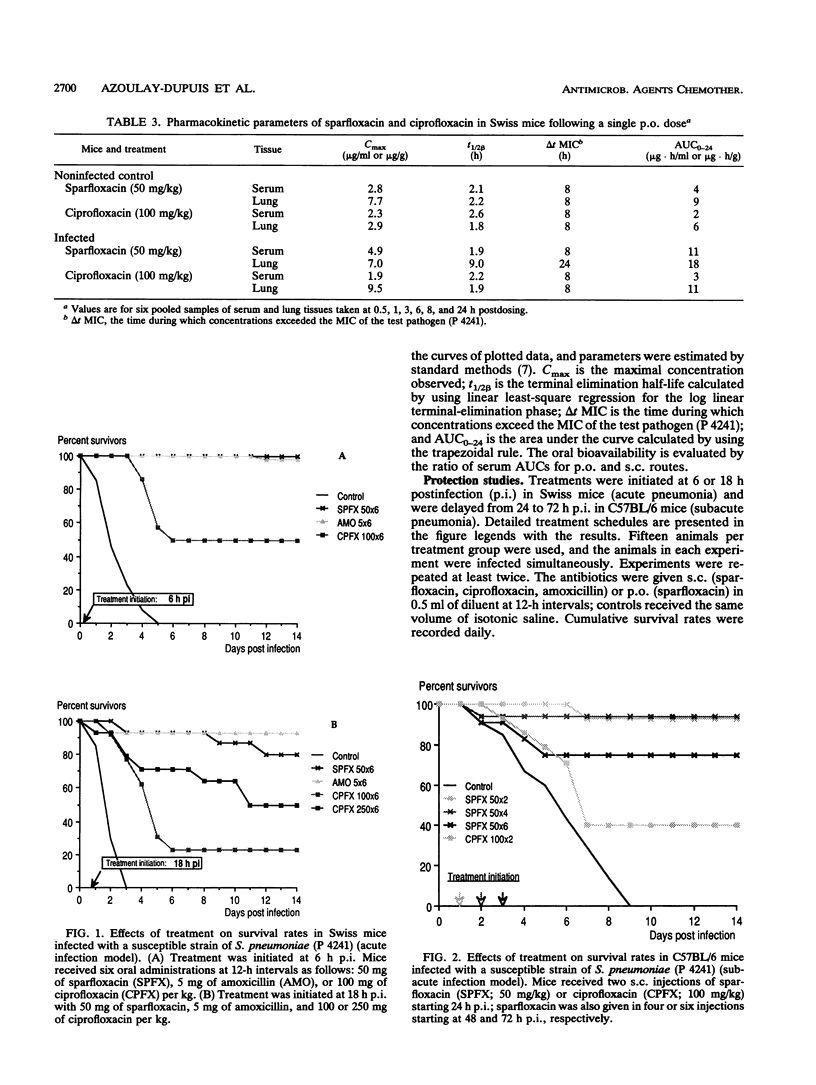
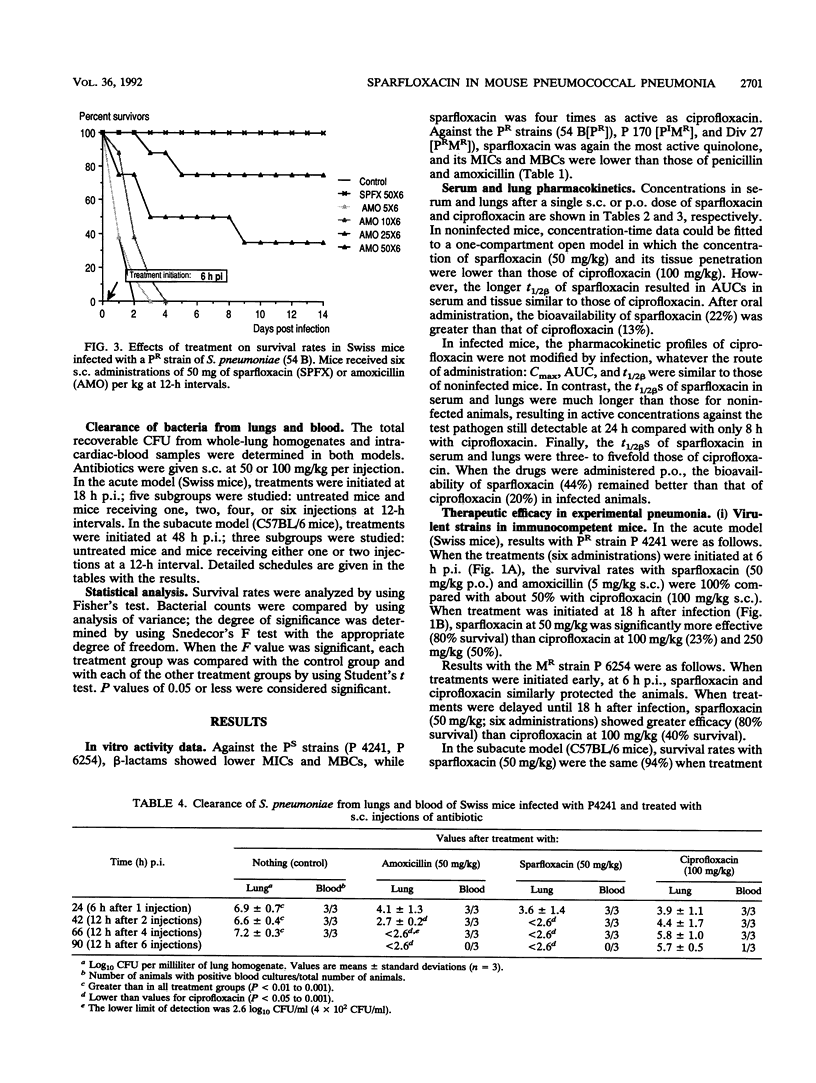
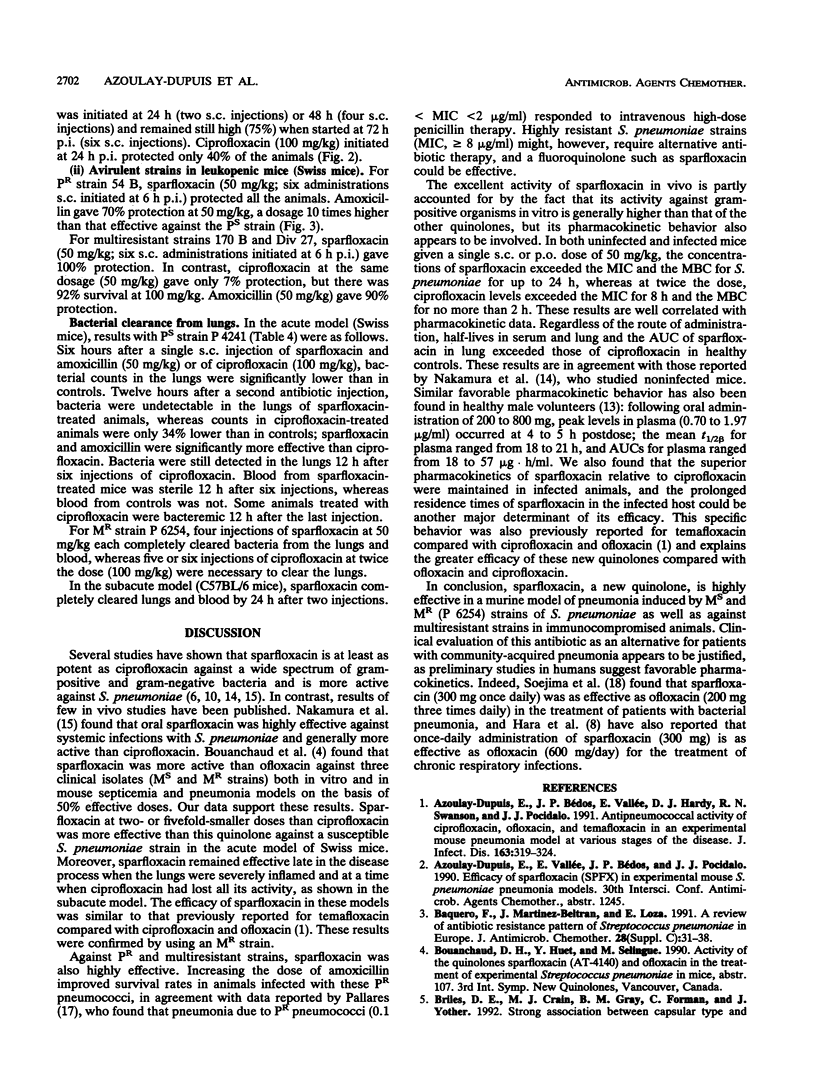

Selected References
These references are in PubMed. This may not be the complete list of references from this article.
- Azoulay-Dupuis E., Bedos J. P., Vallée E., Hardy D. J., Swanson R. N., Pocidalo J. J. Antipneumococcal activity of ciprofloxacin, ofloxacin, and temafloxacin in an experimental mouse pneumonia model at various stages of the disease. J Infect Dis. 1991 Feb;163(2):319–324. doi: 10.1093/infdis/163.2.319. [DOI] [PubMed] [Google Scholar]
- Baquero F., Martínez-Beltrán J., Loza E. A review of antibiotic resistance patterns of Streptococcus pneumoniae in Europe. J Antimicrob Chemother. 1991 Dec;28 (Suppl 100):31–38. doi: 10.1093/jac/28.suppl_c.31. [DOI] [PubMed] [Google Scholar]
- Briles D. E., Crain M. J., Gray B. M., Forman C., Yother J. Strong association between capsular type and virulence for mice among human isolates of Streptococcus pneumoniae. Infect Immun. 1992 Jan;60(1):111–116. doi: 10.1128/iai.60.1.111-116.1992. [DOI] [PMC free article] [PubMed] [Google Scholar]
- Doebbeling B. N., Pfaller M. A., Bale M. J., Wenzel R. P. Comparative in vitro activity of the new quinolone sparfloxacin (CI-978, AT-4140) against nosocomial gram-negative bloodstream isolates. Eur J Clin Microbiol Infect Dis. 1990 Apr;9(4):298–301. doi: 10.1007/BF01968067. [DOI] [PubMed] [Google Scholar]
- Greenblatt D. J., Kock-Weser J. Drug therapy. Clinical Pharmacokinetics (first of two parts). N Engl J Med. 1975 Oct 2;293(14):702–705. doi: 10.1056/NEJM197510022931406. [DOI] [PubMed] [Google Scholar]
- Klugman K. P. Pneumococcal resistance to antibiotics. Clin Microbiol Rev. 1990 Apr;3(2):171–196. doi: 10.1128/cmr.3.2.171. [DOI] [PMC free article] [PubMed] [Google Scholar]
- Kojima T., Inoue M., Mitsuhashi S. In vitro activity of AT-4140 against clinical bacterial isolates. Antimicrob Agents Chemother. 1989 Nov;33(11):1980–1988. doi: 10.1128/aac.33.11.1980. [DOI] [PMC free article] [PubMed] [Google Scholar]
- Kojima T., Inoue M., Mitsuhashi S. In vitro activity of AT-4140 against quinolone- and methicillin-resistant Staphylococcus aureus. Antimicrob Agents Chemother. 1990 Jun;34(6):1123–1127. doi: 10.1128/aac.34.6.1123. [DOI] [PMC free article] [PubMed] [Google Scholar]
- Lévy M., Dromer F., Brion N., Leturdu F., Carbon C. Community-acquired pneumonia. Importance of initial noninvasive bacteriologic and radiographic investigations. Chest. 1988 Jan;93(1):43–48. doi: 10.1378/chest.93.1.43. [DOI] [PubMed] [Google Scholar]
- Nakamura S., Kurobe N., Ohue T., Hashimoto M., Shimizu M. Pharmacokinetics of a novel quinolone, AT-4140, in animals. Antimicrob Agents Chemother. 1990 Jan;34(1):89–93. doi: 10.1128/aac.34.1.89. [DOI] [PMC free article] [PubMed] [Google Scholar]
- Nakamura S., Minami A., Nakata K., Kurobe N., Kouno K., Sakaguchi Y., Kashimoto S., Yoshida H., Kojima T., Ohue T. In vitro and in vivo antibacterial activities of AT-4140, a new broad-spectrum quinolone. Antimicrob Agents Chemother. 1989 Aug;33(8):1167–1173. doi: 10.1128/aac.33.8.1167. [DOI] [PMC free article] [PubMed] [Google Scholar]
- Pallares R., Gudiol F., Liñares J., Ariza J., Rufi G., Murgui L., Dorca J., Viladrich P. F. Risk factors and response to antibiotic therapy in adults with bacteremic pneumonia caused by penicillin-resistant pneumococci. N Engl J Med. 1987 Jul 2;317(1):18–22. doi: 10.1056/NEJM198707023170104. [DOI] [PubMed] [Google Scholar]


